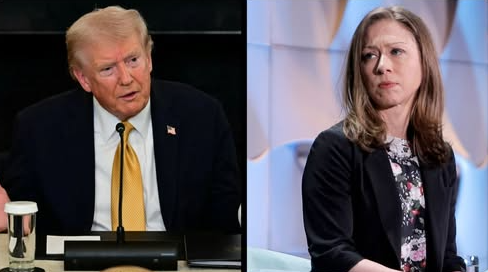As the rumble of bulldozers echoed across one of the most famous and historically significant landmarks in the United States, the nation found itself at the center of an unexpected cultural and political storm. Chelsea Clinton, known not just for her lineage but also for her active role in public discourse, stepped forward with sharp criticism, directly addressing President Donald Trump’s controversial decision to modernize and reshape part of the landmark. Her statements reverberated through social media platforms, television networks, and opinion columns, capturing the attention of millions who had long held a vested interest in preserving the nation’s historical and cultural heritage. In a scathing op-ed published by USA Today, Chelsea did not mince words: she accused President Trump of “taking a wrecking ball to our heritage,” invoking imagery that immediately resonated with readers and painted a vivid picture of destruction and carelessness at the highest level of power. Her words were layered with both personal passion and historical concern, reflecting an understanding that the actions taken at such a landmark carry symbolism far beyond the physical bricks and mortar.
The focus of her criticism was the $250 million demolition of a significant portion of the East Wing, a section of the landmark revered not only for its architectural elegance but also for its centuries-long role in American history. The demolition was undertaken to make way for a privately funded ballroom, a new addition that proponents argued would serve as a symbol of modernity and prestige. However, Chelsea Clinton framed the project as emblematic of President Trump’s “disregard for history” and “obsession with spectacle,” suggesting that the transformation was less about functional improvement and more about personal vanity, ego, and the pursuit of a flashy legacy. She emphasized that historical sites are not merely spaces for aesthetic experimentation but serve as repositories of collective memory, places where the story of the nation and its values are preserved and celebrated for future generations. The proposed changes, she argued, risked erasing centuries of architectural, cultural, and political significance, reducing a sacred site into a stage for personal display.
President Trump, for his part, has defended the project vigorously. Speaking to press members and through official statements, he characterized the East Wing renovation as a “world-class modernization” effort, asserting that the improvements would bring the landmark into the 21st century while respecting the building’s operational needs. He stressed repeatedly that the $250 million cost would be covered entirely through private donations, an attempt to preempt criticisms of taxpayer burden. Trump’s supporters have echoed this narrative, framing the project as a bold move to leave a lasting imprint on one of the nation’s most recognizable institutions. Many of them argue that modernization is necessary to maintain functionality and to provide facilities that accommodate modern events, state functions, and international visitors, claiming that the addition of a grand ballroom would enhance the landmark’s relevance in contemporary society. They see the renovations not as an affront to history but as a courageous and visionary step toward maintaining its grandeur and ensuring that the landmark remains a functional, living part of the nation’s civic life.
Critics, however, remain unwavering in their opposition. Hillary Clinton, a former Secretary of State and Chelsea’s mother, publicly weighed in via X (formerly Twitter), emphasizing the broader implications of the project. “It’s not his house. It’s your house. And he’s destroying it,” she wrote, making a pointed appeal to the American people’s sense of ownership and shared responsibility for national heritage. Her words underscored the idea that certain sites in the country are held in trust for the public, carrying meaning far beyond the preferences or whims of any one individual, regardless of their position of power. In interviews following her post, Hillary elaborated that while modernization is not inherently negative, it must be undertaken with extreme sensitivity, respect, and consultation with historians, preservationists, and the broader public to ensure that the cultural and historical significance of the site is not diminished in the process.
The clash between these perspectives has grown into something more profound than a mere debate over bricks, beams, and architectural design. For many, the conversation has become emblematic of a larger struggle over how America remembers itself, the values it prioritizes, and the balance between legacy, power, and collective memory. The East Wing, long admired for its intricate design and historical significance, has become a battleground where questions of aesthetics, cultural preservation, and political influence converge. Architects, historians, preservation societies, and cultural commentators have joined the discussion, each offering nuanced perspectives on the responsibilities that come with managing such a landmark. Some have raised concerns about the potential loss of historical documentation embedded in the original structure, the integrity of century-old materials, and the precedent it sets for future administrations. Others have debated the philosophical question of whether historical preservation should yield to innovation and modernization, particularly when modernization is privately funded and not reliant on public expenditure.
As construction continues, the rumble of heavy machinery contrasts sharply with the voices of dissent echoing through media channels and social platforms. The debate has sparked community meetings, editorials, and interviews that examine not just the structural transformation itself but the symbolism behind the changes. It has become a lens through which Americans are reevaluating questions of stewardship, the preservation of collective memory, and the ethical obligations of leadership. In essence, what was initially a matter of architectural renovation has expanded into a national conversation about identity, history, and values—a reminder that decisions affecting iconic landmarks extend far beyond the immediate visual impact. The East Wing, long a silent witness to history, now occupies center stage in a cultural and political dialogue that will likely shape public expectations of how the nation’s heritage should be protected for generations to come.
